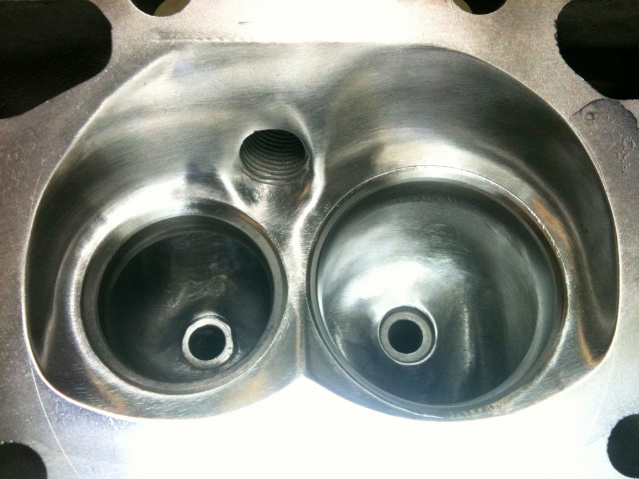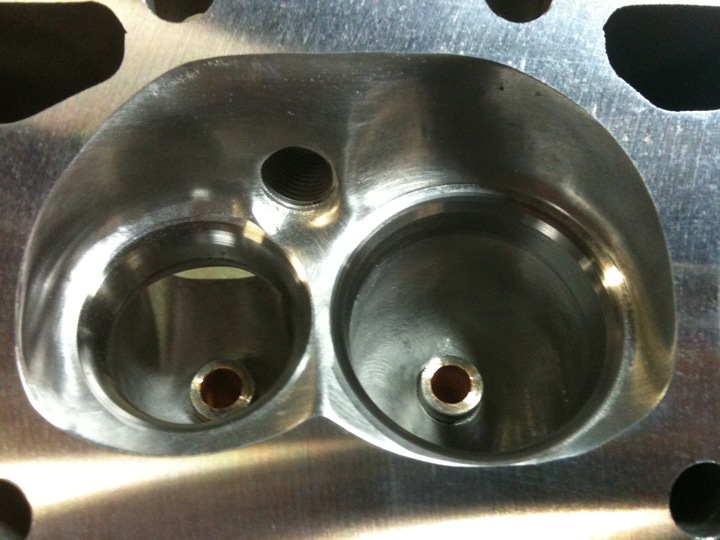http://kb-silvolite.com/article.php?action=read&A_id=36
COMPRESSION RATIO -vs- COMPRESSION PRESSURE
Compression Ratio as a term sounds very descriptive. Compression ratio by itself, however, is like torque without RPM or tire diameter without a gear ratio. Compression ratio is only useful when other factors accompany it. Compression pressure is what the engine actually sees. High compression pressure increases the tendency toward detonation, while low compression pressure reduces performance and economy. Compression pressure varies in an engine every time the throttle is moved. Valve size, engine RPM, cylinder head, manifold and cam design, carburetor size, altitude, fuel engine/air temperature and compression ratio all combine to determine compression pressure. Supercharging and turbocharging can drastically alter compression pressures.
The goal of most performance engine designs is to utilize the highest possible compression pressure without causing detonation or a detonation-related failure. A full understanding of the interrelationship between compression ratio, compression pressure, and detonation is essential if engine performance is to be optimized. Understanding compression pressure is especially important to the engine builder that builds to a rule book that specifies a fixed compression ratio. The rule book engine may be restricted to a 9:1 ratio, but is usually not restricted to a specific compression pressure. Optimized air flow and cam timing can make a 9:1 engine act like a 10:1 engine. Restrictor plate or limited size carburetor engines can often run compression ratios impractical for unlimited engines. A 15:1 engine breathing through a restrictor plate may see less compression pressure than an 11:l unrestricted engine. The restrictor plate reduces the air to the cylinder and limits the compression pressure and lowers the octane requirements of the engine at higher RPM.
At one time compression pressure above a true 8:1 was considered impractical. It still is in many cases with today's gas. The heat of compression, plus residual cylinder head and piston heat, initiated detonation when 8:1 was exceeded. Some of the 60's 11:1 factory compression ratio engines were 11:1 in ratio, but only 8:1 in compression pressure. The pressure was reduced by closing the intake valve late. The late closing, long duration intake caused the engine to back pump the air/fuel mix into the intake manifold at speeds below 4500 RPM. The long intake duration prevented excess compresson pressure up to 4500 RPM and improved high RPM operation. Above 4500 RPM detonation was not a serious problem because the air/fuel mix entering the cylinder was in a high state of activity and the higher RPM limited cylinder pressure due to the short time available for cylinder filling.
The following compression guide should be considered realistic for sea level operation. Cam timing and special applications can move the recommendations around some, but in most cases the following recommendations work.
PUMP GAS (regular)
8.5:1-Non-quench 2 valve head road use standard sedan, without knock sensor.
8.5:1- Quench head engine for tow service, motor home and truck with torque cam.
9.0:1- Street engine with proper .040" quench, 200° @ .050" lift cam, iron head, sea level operation.
9.5:1- Same as 9:1 except aluminum head used. Light vehicle and no towing.
10:1- Used and built as the 9.5:1 engine with more than 220° @ .050" lift cam.
10:1- 4" and smaller bore, high RPM cam, cold plugs, good fuel distribution, full power limited to 30 seconds W.O.T.
RACE GAS
13:1- is the highest compression ratio suggested with unrestricted gasoline engines.
13:1- Plus o'kay with restricted intake engines at high RPM.
ALCOHOL
15.5:1- is the highest compression ratio suggested for unrestricted alcohol fuel engines. Probably will lose power at 15.5:1 in most applications.
Satisfactory use of 14:l - 17:1 compression engines can be made when restrictor plate or small carburetor use are mandated by race sanctioning. High altitude reduces cylinder pressure, so if you only drive at high (above 4500') altitude, a 10:1 engine can often be substituted for a 9:1 compression engine. General compression rules can be violated, but it is usually a very special case, such as a 600 Hp normally aspirated engine in a 1500 lb. street car with a 12:1 compression ratio. The radical cam timing necessary for this level of performance keeps low and medium RPM cylinder pressure fairly low. At high RPM, detonation is less of a problem due to chamber turbulence, reduced cylinder fill time, and the fact that you just can't leave the above conbination turned on very long without serious non-engine related consequences.
Piston temperature and Hp are interrelated. High Hp per cubic inch engines not only make more Hp, but they make more heat. How the excess heat is handled has a significant effect on total engine power and longevity. Some engines have ceramic exhaust port insulation lines that allow cooler cylinder head operation, while keeping exhaust temperatures elevated for efficient catalytic converter operation. The same ceramic-type insulation on a piston top has not been quite so successful. Ceramic insulation on pistons can insulate the piston too well. The piston stays cool while the very top surface gets so hot that the intake air is immediately heated on contact with the piston. The heated intake charge expands and reduces the air flow into the cylinder.
On the compression cycle, the now over heated intake charge offers more resistance to being compressed and, because of the higher compression pressure and temperature, is more likely to detonate during combustion. Ideal piston temperatures in an operating engine would suggest refrigeration during the intake and compression stroke, and incandescence during the combustion and exhaust stroke. The advantage of a hot piston on the power stroke is that less combustion energy is going to be absorbed by the piston. So far, it is not practical to heat and refrigerate a piston 6000 times a minute. However, if the incoming air is not heated by the piston and the piston reflects the heat of combustion, you start to approach ideal conditions. A polished piston runs during the power stroke. A smooth polished piston runs cooler than a non-polished piston even after combustion deposits have turned both pistons black. A cool, smooth piston will transmit a minimum of heat to the incoming fuel air mix.
The KB Performance Piston line gives the racer a real "out of the box" advantage with smooth, diamond-turned piston heads. A polish is relatively easy to achieve and does improve the already excellent reflectivity of the KB Piston. If a buffing wheel is used on hypereutectic pistons, you will note a gray cast to the finished piston. The gray results from the exposure of the silicon particles that are dispersed throughtout the piston. Our forged pistons will polish like chrome.
Experimental work to reduce piston heating of the incoming fuel mix has been very limited, but in theory a thin coating may prove to be beneficial. A thin, smooth coating over a polished piston should still reflect combustion heat while reducing caron buildup and protecting the piston polish. It is easier for a thin film to change temperature with each engine cycle than it is for the whole piston to do the same. A thin film can be cooled by the first small percentage of inlet fuel mix, allowing the main quantity of fuel mix to remain relatively cool. Tests have shown that polishing the combustion chamber, valves and piston top can increase Hp and fuel economy by 6%. So far it has proven difficult to keep a coating on a polished piston.
All this polishing is counter to the practice of dimpling the combustion chamber. Dimpling has been shown to put wet flow back into the air flow and improve combustion. We do not recommend dimpling, but do suggest cutting a small discontinuity close to the valve seat to turbulate wet flow. Some bench flowed cylinder heads encourage fuel separaton at the inlet port. If a small step is added at the valve seat to force the wet flow over the resulting sharp edge, fuel will re-enter the air stream and give you the same affect as dimpling, only without losing the benefit of a completely polished chamber.
As you re-atomize wet flow you will improve combustion and most likely need to install leaner carburetor jets. Leaner jets compensate for the excess fuel that is available when we flow is put back into the air/fuel mix. Significant additional Hp gains can be had with careful attention to cylinder-to-cyliner fuel distribution by allowing all cylinders to be set "just right." More on this in the "Combustion Science and Theory" article.
Combustion chamber design work has increased steadily in the last ten years. Some of the work is mandated by the EPA and some is the result of race engine development. Some of the smog work has actually enhanced race engine development. Combustion chamber science is now focused on the effects of swirl, tumbling, shrouding of the valve, quench, flame travel, wet flow and spark location. A combustion chamber shaped dish piston can improve the flame travel in the combustion chamber, but may increase piston temperature. A new step dish allows the flame to travel further and expand more before it is stopped by a metal surface. This rapid flame travel makes it unnecessary to run big spark advance numbers. Ideally, we would like to be able to initiate ignition at top dead center since this would reduce negative torque in the engine that now results from spark advance. We are some time away from a practical spark ignition system that will make optimum power with a TDC setting. Don't go out and buy dished pistons for your non-supercharged open chamber 454. The advantage in flame travel is more than offset by the low compression ratio this conbination yields. Small combustion chambers respond well to dished pistons, expecially reversed dome "D" cups and step dish. A 400 small block Chevy can use a 22cc D-cup piston and still have 10.4:1 compression. A trend in modern engine design to smaller combustion chambers with slightly recessed piston tops is resulting in more Hp per cubic inch with less fuel.
Ignition timing on most KB installations should be 30-34 degrees total with full mechanical advance dialed in. More advance may feel better off the line, but the engine lays down as the combustion chamber components come up to temerature. At the drag strip set timing for maximum MPH, not best ET. Even at max MPH (max Hp) you likely have 4 cylinders wanting more timing and 4 cylinders wanting less. We worry about the cylinders that want less. Too much spark advance will shorten the life of any engine, sometimes drastically.
John Erb
Chief Engineer
KB Pistons



